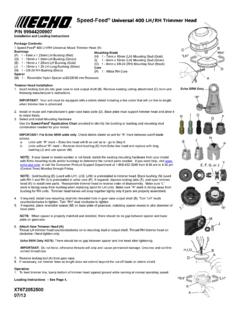Transcription of TECHNOLOGIES DEMONSTRATED AT ECHO: …
1 Copyright 2001 echo , 17391 Durrance Rd., North Ft. Myers FL 33917, USA Phone: (239) 543-3246; Fax: (239) 543-5317 e-mail: website- TECHNOLOGIES DEMONSTRATED AT echo : FLOATING DRUM BIOGAS DIGESTER BY JASON DAHLMAN WITH CHARLIE FORST Published 2001 AN echo TECHNICAL NOTE INTRODUCTION Biogas digesters yield two useful products from animal manure: methane gas (CH4) and a liquid fertilizer. The fertilizer can be applied directly to the garden and CH4 can be used as a source of energy. The three most common and most successful designs for Biogas digesters are the fixed dome, the plastic covered ditch and the floating drum. Charlie Forst, director of echo s appropriate technology department, chose the floating drum design for instructional use at echo . The technology is simple and easy to reproduce. The unit requires about one gallon of slurry per day in order to maintain a charge, and yields about one hour of burn time per day.
2 This is enough to cook rice for four people. More floating drums can be added to generate more gas. The other units mentioned above are more substantial and produce a higher yield of CH4 and liquid fertilizer, but they are also more expensive and complicated to set up. Below are instructions for our floating drum system. MATERIALS NEEDED FOR THE FLOATING DRUM DIGESTER: 2 50-gallon drums (one with a tight fitting lid) 1 smaller drum (we use a 40 gallon plastic garbage can) 4' piece of PVC pipe 5" diameter 2 pieces of plastic tubing 8' long and 1" diameter 1 valve to moderate flow of methane SET-UP Cut a hole in the lid of one of the 50-gallon drums, near the outer edge. The hole should be the same diameter as the PVC pipe. Now cut away a two foot section of half the PVC pipe as shown in the illustration at the right (PVC can be cut with a saw).
3 Slide the pipe into the hole and all the way down until it rests on the bottom of the drum. Seal the fitting between the pipe and the lid with waterproof epoxy sealant or any other tight sealing method. Page 2 Biogas Digester Now cut a smaller hole (sized to fit the tubing) near the opposite edge of the lid and attach one of the pieces of 1"diameter tubing with waterproof epoxy. Run the tubing into the bottom of the 40 gallon drum, and slide it into the drum so that it runs the depth of the drum. Be certain to seal all fittings with epoxy or with an equivalent sealing method. Cut a second hole in the bottom of the 40-gallon drum, sized to fit the valve from the tubing. Attach the valve to the hole. Fill the second 50-gallon drum (without a lid) with water. Invert the 40-gallon drum, open the valve, slide the drum into the 50-gallon drum with water, and then close the valve.
4 Now your digester is set up and ready to be filled with a manure slurry. Biogas Digester Page 3 Manure from any type of farm animal can be used. Cow and pig manure tend to be among the best for a Biogas digester because they tend to be less fibrous than other kinds. Harvest the manure into a bucket and add water. Mix the water and manure until it forms a slurry of a thin enough consistency to be poured into the digester (about 50% water, 50% manure). It is best to start your digester with an initial charge of 50 gallons (or whatever the capacity of your container is). Subsequently you can add manure as needed. Ours usually takes about a gallon a day. You will need to add about 2% of your digester s volume daily. Fill the digester by pouring the slurry into the PVC pipe. BE SURE that the level of slurry is always maintained at a level higher than the cut-away part of the pipe.
5 If the level drops below this point, gas will escape out the top of the pipe. Before adding new slurry, an equal volume of slurry must be removed from the 4 inch charging tube. This can be done using a bailer for example, you can use a tin can attached to a stick. The removed slurry can be used immediately and at full strength as a garden fertilizer. Once the digester is charged there will be a waiting period before the manure begins to cook and release CH4 and carbon dioxide (CO2). The digester does not need to be in direct sun but it should be in a place that heats up to at least 80 degrees F during the day. Depending on ambient temperatures, you may need to wait seven to ten days for gas production to begin. As the temperature rises the manure will start fermenting and releasing gas. The gas flows through the plastic tube and is released into the inverted 40 gallon drum.
6 It bubbles out into the water where the CO2 is dispersed and methane gas bubbles to the top. As the drum fills with methane, it will start to rise up in the water. Once the drum has risen, you can begin using your methane as a fuel. At this point you can connect your methane blow-off tube to a cookstove and start running your stove with naturally generated methane gas. Alternatively, you can hook up the gas to a lantern for a methane powered light. You may increase the pressure of the gas output by placing a brick on top of the inverted 40-gallon drum that holds the methane. You may add additional inverted 40 gallon gas reservoirs as needed. OTHER RESOURCES There are many books available on this topic. Here are three which we have found helpful: Bio-Gas Plant by Ram Bux Singh, published by Mother s Print Shop 1975. Methane: Planning a digester by Peter-John Meynell, published by Shocken Books 1978.
7 Improved Biogas Unit for Developing Countries by Ludwig Sasse, Christopher Kellner, and Ainea Kimaro. Published by GATE (German Appropriate Technology Exchange).







